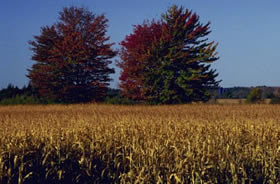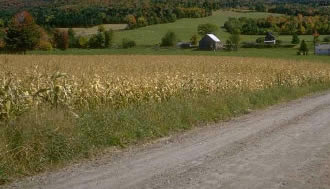|
We know that heavy use of pesticides by farmers is a problem. Pesticides harm beneficial insects at the same time they're killing pests. They drift via the air to contaminate nearby properties and people. They contaminate groundwater, streams, and rivers via rainwater and irrigation runoff. They also harm farmers and farm workers. And as regular consumers of food, it's likely that none of us are too enthusiastic that we're regularly eating our meals with a small serving of pesticide residue on the side. Waiter! What's this organophosphate doing in my soup??
Instead of spraying pesticides all over our farm fields, wouldn't if be cool if someone could find a natural substance with low human and environmental toxicity and incorporate it directly into plants, thus making crops naturally resistant to pests? Enter Bt.
Bt corn, Bt cotton, and Bt potatoes are genetically engineered plants that incorporate Bt, a natural toxin from the microorganism Bacillus thuringiensis that is deadly to many pest species but has low toxicity for most benign organisms, beneficial predators, and humans.
 Wow, great—we can stop using all those lethal chemical pesticides! Unfortunately, there's more to the story...
Wow, great—we can stop using all those lethal chemical pesticides! Unfortunately, there's more to the story...
The main idea behind genetically engineered (GE) Bt crops is that they eliminate the need for conventional farmers—those who have traditionally used chemical pesticides—to apply insecticides to their crops, which is better for the environment and cheaper for the farmer. But Bt is not a new approach dreamed up in the bowels of one the agribusiness corporations. Bt spray has been used for decades for pest control and has been a particularly important tool for organic farmers, who aren't allowed to use the highly toxic arsenal of chemical pesticides used by "conventional farmers." What's new is that the genetic engineers have figured out how to embed the genetic characteristics of the Bt toxin directly into some plants—primarily corn, cotton, and potatoes—so that they become naturally resistant to pests.
In the past, Bt has been applied topically to plants to control pests, but as with any other pesticide, rain eventually washes it off and the Bt spray must be applied again, running up the farmer's costs and labor. Since the Bt corn and cotton have the Bt toxin embedded as part of the genetically engineered plant's cells, the wash-off problem is eliminated.
All that sounds good in theory, but there is a big problem with Bt crops. Prior use of Bt by farmers has always been on an as-needed basis and in combination with other insect control techniques. This intermittent use has prevented insects from developing resistance to Bt. With Bt corn and cotton, the insects are constantly exposed, and it is thus inevitable that insect will develop resistance to Bt. (Resistance is not a phenomenon specific to Bt—insects develop resistance to regularly applied chemical pesticides, too.)
There are a couple of aspects to the development of resistance in genetically engineered Bt crops. First, the obvious way: Insects eating Bt crops are constantly being exposed to the pesticide and, over time, subsequent generations of the insects will eventually become resistant. But there is another factor: Because crops grow unevenly in nature's differing conditions and because expression of the Bt gene is not uniform throughout the plant, some pests will get a "sub-lethal dose" of Bt toxin, which will facilitate the development of resistance in the same way that pathogenic bacteria become resistant when a patient fails to complete the full course of an antibiotic.
The US Environmental Protection Agency claims to be addressing the resistance concern by requiring that crop acres be set aside where non-Bt crops must be grown to serve as a "refuge." The idea is that the refuge acres will support populations of insects where they are not exposed to the Bt toxin. When the insect populations
 in the refuges cross-breed with insects in the Bt fields, the mixed genetics will help prevent resistance development. This approach and other techniques could help, but it has already been documented that growers of Bt crops are regularly found to be non-compliant with their resistance management plans. They have a natural inclination against "wasting" valuable crop space by planting fodder for insects.
in the refuges cross-breed with insects in the Bt fields, the mixed genetics will help prevent resistance development. This approach and other techniques could help, but it has already been documented that growers of Bt crops are regularly found to be non-compliant with their resistance management plans. They have a natural inclination against "wasting" valuable crop space by planting fodder for insects.
If Bt crops continue to be grown, development of Bt resistance in insect populations is a certainty, regardless of the best intentions of the regulators and manufacturers.
Are the manufacturers of genetically engineered Bt crops worried about the demise of Bt? Consider the following statement about Bt resistance from Hugh Grant—no, not THAT Hugh Grant—but rather the Hugh Grant who is the President and CEO for Monsanto: "Resistance is something that we take very, very seriously. We've made investments in these technologies for a decade. So, it's in our interest to make sure that they last for another 10 or 20 years."
Ten or 20 years?? Farmers have already been using Bt responsibly for far longer than 20 years and will continue to use it for an unlimited time into the future—unless Monsanto and other companies are allowed to continue to market agricultural products that will ultimately subvert Bt's toxicity to pests.
Monsanto justifies "using up" Bt's potency by saying that they'll have some new effective solution by the time Bt is kaput. Translation: They think it's perfectly OK that they be allowed to suck all the future usefulness—and profits—out of Bt in a period of 10-20 years and leave the responsible users of Bt high and dry. Or more accurately—leave them with no alternative but to come to Monsanto in 10-20 years for The New Solution.
 So, should we throw Bt corn, cotton, potatoes and other potential Bt crops on the Big Compost Heap of Bad Ideas? While it is true that some reduction in pesticide use and improvements in yield have been associated with these crops, the improvements will only last until the insects achieve resistance. That's a short-term gain at long-term expense.
So, should we throw Bt corn, cotton, potatoes and other potential Bt crops on the Big Compost Heap of Bad Ideas? While it is true that some reduction in pesticide use and improvements in yield have been associated with these crops, the improvements will only last until the insects achieve resistance. That's a short-term gain at long-term expense.
There are scenarios in which a crop like Bt cotton could be used as part of a multi-faceted insect-control approach, but such schemes are complicated, and we've already seen that many farmers won't follow even simple requirements like planting a certain amount of acreage in non-Bt crops.
Once insect populations become resistant to Bt, the process cannot be reversed—Bt will be gone. Until all of the questions about GE crops with Bt are thoroughly evaluated and proper sustainability protocols can be developed and enforced, these crops should not be in allowed our farm fields at all.
What can you personally do about it? Well, other than expressing your concerns over this issue to your senators and congressional representatives—as well as federal and local agriculture regulators—you can buy organic food and "no-GMO" food, neither of which are sourced from Bt crops.
|
And now, we're off now to watch "Bt-man and Robin" on TV. It's the episode where the Dynamic Duo takes on Poison Ivy, who is just back from a genetic-engineering makeover.
|
|
allerGEnic |
|
Bt in food crops could also prove to be a problem for humans. In 2000, a US EPA Scientific Advisory Panel of 16 physicians and independent scientists reported that the particular Bt protein in StarLink corn was a potential allergen, and StarLink corn was thus banned from use in human food. Less obvious allergenic properties could manifest in other Bt crops over time.
|
|
Know someone who might find this article interesting?
Please forward it to them
Related articles:
More articles and resources on....
Get Grinning Planet free via email
|


